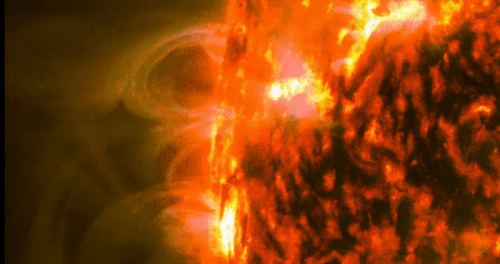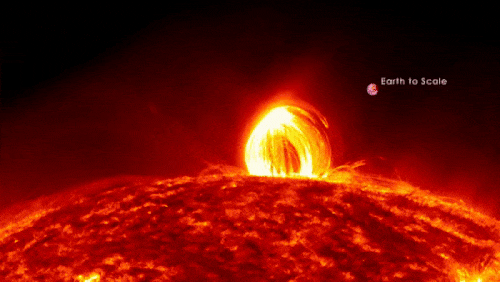4 Scientific Marvels Hiding In Our Solar System

Space is full of wonders. And some are right on our doorstep. Which is fortunate since spacetime is nearly 14-billion-years-old and (owing to expansion) about 94 billion light-years in diameter. So even though the universe teases us with mind-blowing phenomena eternally out of our reach -- picture the orphan-driver denying little Oliver Twist another bowl of watery gruel -- it throws us a few crumbs of sweet, sweet space-sustenance near enough to enjoy up close (ish).
Plasma Rain On The Sun
NASA's Solar Dynamics Observatory (SDO) was launched in 2010 and dutifully keeps an eye on the Sun to warn us whether it's bathing suit season or solar flare-doomsday season. It has also shown in unprecedented detail all the cool stuff the Sun does. Like on July 19, 2012, when SDO captured something we're all familiar with: rain. But on the goddamned Sun.
Each second corresponds to six minutes of real-time because the Sun does everything at its leisure, and who's going to tell it otherwise? This "coronal rain" also shines brightly in the extreme UV wavelength. Its brilliance translates to temperatures of 50,000 K or nearly 90,000 degrees Fahrenheit -- though that's still not very hot for a bowl of cosmic gruel, as we'll get to in a second.
Coronal rain works like Earth's rain, and the mechanics are "literally the same." Stuff gets warmer, floats up into the atmosphere, cools, condenses, and falls (or rains, if you will) back down to the surface. On Earth, that stuff is water. On the Sun, it's plasma, electrified gas glowing at more than a million degrees. Around the feet of these magnetic loops, where they connect to the Sun's surface, the scorching plasma is "superheated" from just several thousand degrees to nearly 2 million degrees Fahrenheit.

This scalding nightmare rain generally occurs after a solar flare, as per the video above. But it can also happen whenever it feels like it because, again, who's gonna bully the Sun? You!? Other than being gnarly as all hell, plasma rain impressively displays an invisible phenomenon, magnetism. Since the roiling electric gas is electric, it traces the Sun's magnetic lines. And check out how terrifyingly immense they are:

As you can see from the horrifyingly-supplied size comparison, Earth is just a tiny, trifling, piddling peanut in even the tiny scheme of our solar front porch. And when these loops do a biiig streeetch, like your cat, they can rise 30,000 miles above the solar surface. These events are long-lasting, too, creating 30-hour-long showers. Showers of incandescent burning death. Remember this next time you curse your luck for getting caught in a light drizzle without an umbrella.
Venusian Volcanoes
Earth's similarly-sized, massed, and chemically composed twin planet, Venus, may not be as dead as thought, but a world alive with infernal geology. Including magma flows, lava vents, shifting landscapes, and volcanoes. Lots of volcanoes. Our terrible twin supports about 1,600 major 'canoes and maybe more than a million smaller ones.
Researchers also identified 37 coronae, circular crater-like features named after corona—not the beer, but the Latin word for crown. These coronae suggest recent activity. In space terms, recent can mean millions or hundreds of millions of years. And though that's true here, it's also possible that these MFers are active today. And they can grow very large: Artemis corona would encompass much of the contiguous US.
Others, along with associated structures like "pancakes," double as natural works of abstract art. This one resembles Mickey Mouse's zombified head with a torn-off ear and an exposed zygomatic bone, possibly alluding to Pluto's fate in this MA-rated Disney alt-universe:

In addition to coronae, Venus hosts numerous other strange features etched into its basaltic crust by hot violence. Such as "ticks" and "arachnoids" that would make for amusing astronaut-eating antagonists in a lazy sci-fi flick wherein humans somehow land on Venus to save Earth for some dumb reason, as per Hollywood sci-fi logic.

But since Venus doesn't have plate tectonics, its subsurface magma flows stretch vertically for hundreds of miles as conduits of molten material rise then pool under the crust. The resultant bubbling, seeping, and deforming creates the coronae and other surface blemishes hiding beneath the scorching Venusian atmosphere.

On our planet, volcanic and tectonic processes created and are still creating Hawaii. Oceanic volcanoes ooze island-forming magma, and as the plate above moves, the magma gets deposited in a consecutive span of islands. This is why there is no Hawaii on Mars.
But Venus' southern hemisphere does have something kind of similar. A melty magma belt dubbed "the ring of fire," after Earth's own volcanic ring of fire. But space always one-ups our humble blue marble. Accordingly, the largest corona on Venus is the aforementioned Artemis, 1,300 miles in diameter. Compare that to Earth's biggest, the 75-mile-wide Mauna Loa, and you'll see that our magnificent world constantly plays second fiddle to its planetary kin.
Verona Rupes, The Solar System’s Tallest Cliffs
The 27 moons of Uranus are unique, and not just because they whirl through the blackness of spacetime around a gigantic –anus. Unlike most of the other revolving orbs of the solar system, they're not named after mythological figures but mostly after Shakespearean personages.
Miranda is the innermost and smallest of the five major satellites trapped by the massive gravitational pull of Uranus, no offense.

It's also the most interesting because it's a mismatched patchwork of landforms and textures, as much as a smashed-up Nissan 240SX bought on Craig's List by a college student that just moved out.

Scientists aren't sure why Miranda is one of the (if not the) most haphazardly put-together things in the solar system. The most badass of explanations is that Miranda is a Frankenstein-ian marionette of rock and water ice. It was once bashed to bits by a space collision and then coalesced into a frozen, irregular lump. And by once, we mean possibly five times. Also, it's pockmarked from impacts and kneaded by the gravitational pull of its sibling satellites.

Yet the spellbinding feature for future farers of space is Miranda's natural wonder: Verona Rupes, the pants pooping-est cliffs in the entire solar system at 12-miles-tall. That's 10 times the height of the Grand Canyon. This sounds unlikely since Miranda is an icy pebble approximately 300-miles-wide and has only 0.000011 the mass of Earth.
But space always pulls some rabbit out of its hat, and wouldn't you know it, it placed the cliff-iest cliffs of all not on some planet or giant moon, but on lovely little Miranda. They're so big you can see 'em from space. In addition to inspiring feelings of sickness in our guts, they've also inspired some groovy science fan art, including, oddly enough, a bath towel so awe-inspiring it's a shame its destiny is to dry ballsacks.
Also of note for cosmic adventure-sports-aficionados of the 2200s, Verona Rupes is so gargantuan, and Miranda's gravity so piddly that if you jumped, fell, or were pushed from their pinnacle, you'd have time to make pasta on the way down. The plunge would last about 12 minutes before you slammed into Miranda's eclectic topography at over 120 miles per hour.
Titan Is An Earth-Like Triple Threat For Weird (Potential) Life
Saturn's moon Titan is about a billion miles (or 90 light-minutes) away and of the most captivating, tantalizingly out-of-reach things ever glimpsed. It's the second-beefiest moon in the solar system at nearly 3,200 miles across, which clowns our 2,200-mile-wide Moon and even our innermost planet, lil' 3,000-mile-diameter Mercury.
Titan is also the most unique and uniquely Earth-like object. First, it's enveloped in a dense orange haze. Kinda similar to our atmosphere, it's made mostly of nitrogen. But unlike ours, it combines its nitrogen with methane, making this smog as healthful as the iridescent, twice-discounted rockfish with the scribbled-out expiration date at your local international market.
Additionally, Titan is the only world with active liquids on its surface. And not just a few drops but a whole "water" cycle, with liquids that evaporate, form clouds, then rain down as fat, slow-falling drops that flow into lakes, rivers, and seas. Alas, future explorers will scarcely need their arm floaties, as these seas are made of natural gas: ethane and methane, liquefied by genital-inverting temperatures of -290 degrees F.
The largest seas span hundreds of miles in diameter and depth, potentially (fingers crossed) harboring insane lifeforms of mind-boggling biology, unlike anything known to science or even the most free-thinking, peyote-smoking-est astrobiologist. But that's not all: Titan also hides a subterranean liquid water ocean. Surprise! This planet-worthy moon has five distinct layers:

That ocean could hide more familiar types of life, be they shifty cephalopods or maybe cosmic-Kraken or other monstrosities, who the hell knows. And if that wasn't enough, some researchers think Titan sometimes combines the two environments when huge space rocks come hurtling in and crack through the crust. Like the 21-mile-wide impactor that smashed into Titan at 4 miles per second and left the 264-mile-wide Menrva crater a billion years ago.
This, or other impactors, may have pierced the up-to-60-mile-thick crust, forming a lake and mixing the life-building organic materials from the surface with the ocean water below. Add the heat generated by the impact, and bacteria could take shape. So Titan offers at least three distinct, equally interesting avenues for organisms.

Alternatively, imagine if the lethargic, energy-conserving crocodilian monsters of the frigid surface finally got to mingle with their subterranean space-Kraken compatriots and birthed their version of a mule or zorse. The resultant offspring could be among the entire universe's unlikeliest, most intriguing abominations.
Top Image: NASA’s Solar Dynamics Observatory, Kelvinsong/Wiki Commons






